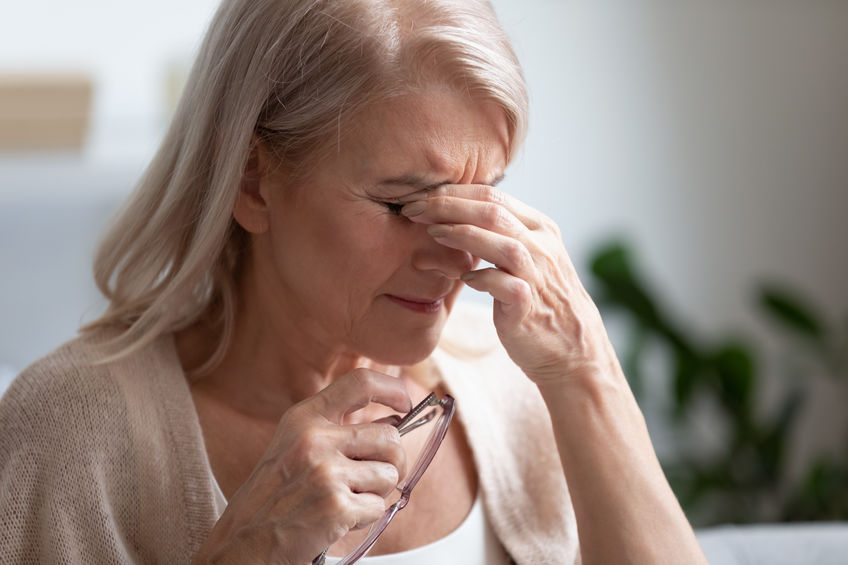What is Dry Eye?
Dry eye is a condition that affects nearly everyone at some point in their life. Dry eye is a disease where the tears or “tear film” on the surface of the eye are not enough to keep the eye protected from the environment. This can cause pain, grittiness, redness, and a burning sensation. There are three major types of dry eye. The three types are evaporative (most common), aqueous deficient, and inflammatory. Evaporative dry eye means the tears evaporate off the eye too quickly, leading to the symptoms described above. Some people simply don’t create enough tears, this is aqueous or “water” deficient dry eye. The third major cause of dry eye is inflammatory, which can relate to the other types, but has its own specific treatment.
What is Mask Associated Dry Eye (MADE)?
Mask associated dry eye or “MADE” was a new type of dry eye coined in 2020 and it is caused by prolonged mask wearing. When we wear a mask, our hot breath rises from the mask and contacts our eyes where it causes rapid evaporation of the thin layer of tears on the front window of our eye, the cornea. When this happens, we immediately feel dryness and blink to recoat our eyes with fresh tears. So how can we alleviate this dryness and prevent it from happening? By addressing the three major causes! Tips on wearing a mask.
How can I treat MADE?
The most important first step is to understand how our tears work. They are not just water! Our tears have both water and oil layers. The water is in contact with the cornea, and the oil layer sits on top to prevent it from evaporating. You can picture this by thinking of an oil and vinegar salad dressing with the oil layer floating on top! Without a proper oil layer, the water layer evaporates right off, especially in dry climates or when a burst of hot air shoots up from your mask. The best way to promote a healthy oil layer in our tears is regular use of warm compresses. These can be made at home or purchased commercially, but the most important part is sustained heat to the closed eyes for at least 10 minutes. You can make yours at home by simply running a washcloth under hot water, ringing it out, and placing it in the microwave for about 20 seconds. Everyone’s microwave is different, so it’s also important to check the temperature of the rag before placing it on your eyes. It should be hot to the touch, but not enough to burn or injure you. A good way to test is touching the towel to the inside of your wrist. If it’s too hot for your wrist, it’s too hot for your eyes! Lubricating eye drops that include an oil like substance are also great for evaporative dry eye. This oil layer helps restore the natural balance of your tears and promotes a healthy tear film. Some lubricating eye drops that include this oil layer are “Refresh Omega-3” and “Systane Balance”, but a generic equivalent will work just fine as well. Another helpful approach is to supplement Omega-3 fatty acids into your diet. Most eye doctors recommend between 1000-2000mg of Omega 3 fatty acids per day. These can be from fish or plant-based sources. Just make sure to talk to your primary care doctor before starting any new supplement as they may not be right for you or could interact with your other medications.
Aqueous deficient and inflammatory dry eye can be grouped together, because inflammatory dry eye often leads to aqueous deficient. Treating the symptoms of aqueous deficient dry eye seems relatively simple, add tears, right? This is correct, but often there is an underlying reason why there aren’t enough tears. This could be something as simple as not drinking enough water, or something more complex like a condition that affects your whole body. It is always the goal of your providers to try to identify the cause of a symptom, not just to mask it. This is where a checkup with an optometrist or ophthalmologist can help. These doctors can review your medical history and eye health to help put together a plan best suited for you and your specific needs. If the dry is eye found to be inflammatory, eye drops like Restasis® and Xiidra® may help. These drops work to regulate your immune system around the eye to promote a healthy amount of tears.
Dry eyes can be a burden that impact quality of life, and even hinder patients from doing the things they like to do. The good news is it doesn’t have to be that way. The “at-home” and “over-the-counter” treatments outlined above are safe and effective to try, and may help, but is also recommended to have your eyes evaluated by a professional. By identifying the cause, and starting the appropriate treatment, dry eye symptoms can be significantly reduced or even eliminated. If dry eyes are a part of your life, speak to your doctors, and they will be happy to assist in making your dry eyes a thing of the past!
Special thanks to optometrist Dr. Ryan Dugan, OD, for his expertise on this subject.












